Ubuntu16.04.1上搭建分布式的Redis集群,并使用C#操作
为什么要集群:
通常为了,提高网站的响应速度,总是把一些经常用到的数据放到内存中,而不是放到数据库中,Redis是一个很好的Cache工具,当然了还有Memcached,这里只讲Redis。在我们的电商系统中,热点数据量往往巨大,比如单点登录、用户浏览商品的信息、用户信息、用户收藏的商品信息、短息提醒数据等等,也都用到了redis,如何使redis可以横向可伸缩扩展,这需要由多台机器协同提供服务,一台挂掉了,另一台马上顶上去,即分布式的redis集群,就对系统的性能非常重要。
Redis集群的几个重要特征:
(1).Redis 集群的分片特征在于将键空间分拆了16384个槽位,每一个节点负责其中一些槽位。
(2).Redis提供一定程度的可用性,可以在某个节点宕机或者不可达的情况下继续处理命令.
(3).Redis 集群中不存在中心(central)节点或者代理(proxy)节点, 集群的其中一个主要设计目标是达到线性可扩展性(linear scalability)。
(4).Redis集群要想正常工作,必须要三个主节点,在我搭建的集群环境中,三个主节点都需要有一个从节点,所以一共六个节点,通俗来讲也就是需要开启6个redis服务。
一、安装Redis
关于如何在Linux上安装Redis,可以参考我的这篇博客,里面有详细的安装步骤,注意在搭建Redis的集群环境我使用的Redis版本为4.0.1《Redis的安装以及在项目中使用Redis的一些总结和体会》。
整体结构:
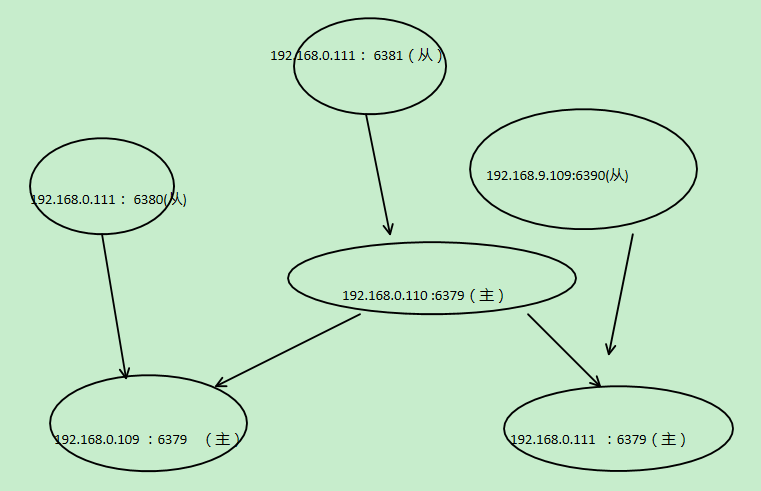
二、进群环境的配置
(1)在这里我就开启三台Ubuntu16.04.1,因为电脑8G的内存不够用,如果你电脑内存大可以开启4台或者更多。在这三台中我都安装好了最新版本的Redis。
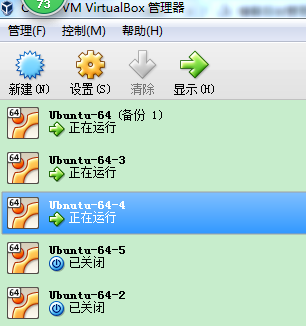
(2)集群配置文件的修改
第一台配置文件的修改:首先在usr/redis目录下,把上面安装好的的redis文件放到该目录下面,具体哪些文件可参考下图。
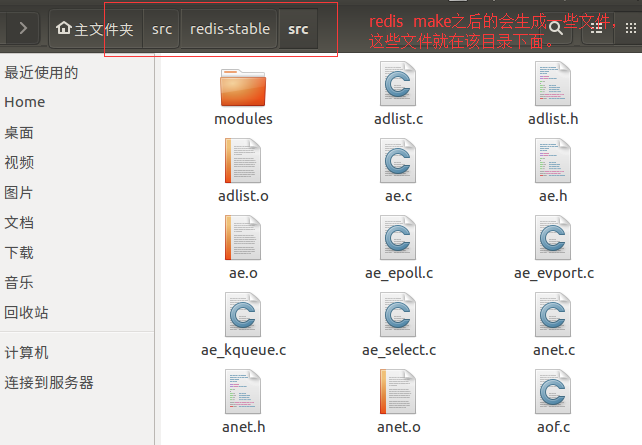
需要的文件有:
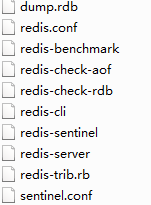
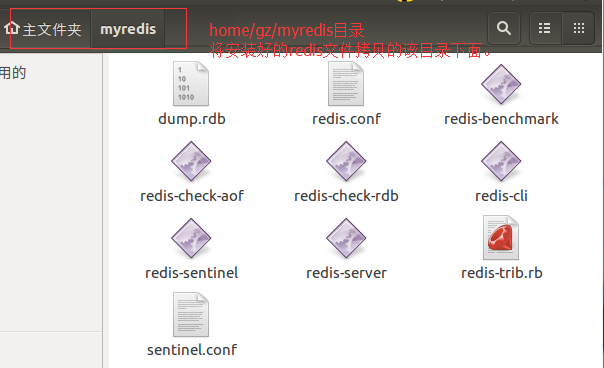
然后通过下面的命令把上面的文件复制到usr/redis/目录下面:
首先在usr目录下面创建一个redis和s2目录:sudo mkdir redis; sudo mkdir s2
目录创建好后,到上面图中的目录下面,打开终端,执行:cp redis* /usr/redis/,上面图中的文件就会到usr/redis/目录下面,最后到usr/redis/目录下面,打开终端,执行sudo cp redis* /usr/redis/s2/,这是该目录下面也就会有相同的文件了。

修改redis.conf文件中Cluster的配置,修改如下:
首先由于权限的问题,我们先要切换到root身份:sudo passwd root命令,先修改root的密码,修改之后,再执行su root 接着输入你设置的root密码就可以切换到root身份,如下:

最后在root身份执行下图中的命令就可修改redis.conf文件:

这里只贴出来修改的代码:(红色标注的部分为修改部分)
# ~~~~~~~~~~~~~~~~~~~~~~~~~~~~~~~~~~~~~~~~~~~~~~~~~~~~~~~~~~~~~~~~~~~~~~~~ # bind 127.0.0.1 //注释掉 # Protected mode is a layer of security protection, in order to avoid that # Redis instances left open on the internet are accessed and exploited. # # When protected mode is on and if: # # 1) The server is not binding explicitly to a set of addresses using the # "bind" directive. # 2) No password is configured. # # The server only accepts connections from clients connecting from the # IPv4 and IPv6 loopback addresses 127.0.0.1 and ::1, and from Unix domain # sockets. # # By default protected mode is enabled. You should disable it only if # you are sure you want clients from other hosts to connect to Redis # even if no authentication is configured, nor a specific set of interfaces # are explicitly listed using the "bind" directive. protected-mode no //yes该为no # Accept connections on the specified port, default is 6379 (IANA #815344). # If port 0 is specified Redis will not listen on a TCP socket. port 6379 # TCP listen() backlog. # # In high requests-per-second environments you need an high backlog in order # to avoid slow clients connections issues. Note that the Linux kernel # will silently truncate it to the value of /proc/sys/net/core/somaxconn so # make sure to raise both the value of somaxconn and tcp_max_syn_backlog # in order to get the desired effect. tcp-backlog 511 # Unix socket. # # Specify the path for the Unix socket that will be used to listen for # incoming connections. There is no default, so Redis will not listen # on a unix socket when not specified. # # unixsocket /tmp/redis.sock # unixsocketperm 700 # Close the connection after a client is idle for N seconds (0 to disable) timeout 0 # TCP keepalive. # # If non-zero, use SO_KEEPALIVE to send TCP ACKs to clients in absence # of communication. This is useful for two reasons: # # 1) Detect dead peers. # 2) Take the connection alive from the point of view of network # equipment in the middle. # # On Linux, the specified value (in seconds) is the period used to send ACKs. # Note that to close the connection the double of the time is needed. # On other kernels the period depends on the kernel configuration. # # A reasonable value for this option is 300 seconds, which is the new # Redis default starting with Redis 3.2.1. tcp-keepalive 300 ################################ REDIS CLUSTER ############################### # # ++++++++++++++++++++++++++++++++++++++++++++++++++++++++++++++++++++++++++++ # WARNING EXPERIMENTAL: Redis Cluster is considered to be stable code, however # in order to mark it as "mature" we need to wait for a non trivial percentage # of users to deploy it in production. # ++++++++++++++++++++++++++++++++++++++++++++++++++++++++++++++++++++++++++++ # # Normal Redis instances can't be part of a Redis Cluster; only nodes that are # started as cluster nodes can. In order to start a Redis instance as a # cluster node enable the cluster support uncommenting the following: # cluster-enabled yes # Every cluster node has a cluster configuration file. This file is not # intended to be edited by hand. It is created and updated by Redis nodes. # Every Redis Cluster node requires a different cluster configuration file. # Make sure that instances running in the same system do not have # overlapping cluster configuration file names. # cluster-config-file nodes-6379.conf # Cluster node timeout is the amount of milliseconds a node must be unreachable # for it to be considered in failure state. # Most other internal time limits are multiple of the node timeout. # # cluster-node-timeout 15000 # A slave of a failing master will avoid to start a failover if its data # looks too old. # # There is no simple way for a slave to actually have an exact measure of # its "data age", so the following two checks are performed: # # 1) If there are multiple slaves able to failover, they exchange messages # in order to try to give an advantage to the slave with the best # replication offset (more data from the master processed). # Slaves will try to get their rank by offset, and apply to the start # of the failover a delay proportional to their rank. # # 2) Every single slave computes the time of the last interaction with # its master. This can be the last ping or command received (if the master # is still in the "connected" state), or the time that elapsed since the # disconnection with the master (if the replication link is currently down). # If the last interaction is too old, the slave will not try to failover # at all. # # The point "2" can be tuned by user. Specifically a slave will not perform # the failover if, since the last interaction with the master, the time # elapsed is greater than: # # (node-timeout * slave-validity-factor) + repl-ping-slave-period # # So for example if node-timeout is 30 seconds, and the slave-validity-factor # is 10, and assuming a default repl-ping-slave-period of 10 seconds, the # slave will not try to failover if it was not able to talk with the master # for longer than 310 seconds. # # A large slave-validity-factor may allow slaves with too old data to failover # a master, while a too small value may prevent the cluster from being able to # elect a slave at all. # # For maximum availability, it is possible to set the slave-validity-factor # to a value of 0, which means, that slaves will always try to failover the # master regardless of the last time they interacted with the master. # (However they'll always try to apply a delay proportional to their # offset rank). # # Zero is the only value able to guarantee that when all the partitions heal # the cluster will always be able to continue. # # cluster-slave-validity-factor 10 # Cluster slaves are able to migrate to orphaned masters, that are masters # that are left without working slaves. This improves the cluster ability # to resist to failures as otherwise an orphaned master can't be failed over # in case of failure if it has no working slaves. # # Slaves migrate to orphaned masters only if there are still at least a # given number of other working slaves for their old master. This number # is the "migration barrier". A migration barrier of 1 means that a slave # will migrate only if there is at least 1 other working slave for its master # and so forth. It usually reflects the number of slaves you want for every # master in your cluster. # # Default is 1 (slaves migrate only if their masters remain with at least # one slave). To disable migration just set it to a very large value. # A value of 0 can be set but is useful only for debugging and dangerous # in production. # # cluster-migration-barrier 1 # By default Redis Cluster nodes stop accepting queries if they detect there # is at least an hash slot uncovered (no available node is serving it). # This way if the cluster is partially down (for example a range of hash slots # are no longer covered) all the cluster becomes, eventually, unavailable. # It automatically returns available as soon as all the slots are covered again. # # However sometimes you want the subset of the cluster which is working, # to continue to accept queries for the part of the key space that is still # covered. In order to do so, just set the cluster-require-full-coverage # option to no. # # cluster-require-full-coverage yes # In order to setup your cluster make sure to read the documentation # available at http://redis.io web site.
修改完之后 按下ESC 键,再按下 :wq!保存突出。同理,s2中的redis也是这样修改的但是,需要修改一下端口号,不能喝上面的端口号重复,s2中的端口号为6390。
使用相同的方式修改第二台上redis的配置:只不过在该台机器上只有一个redis服务(节点)
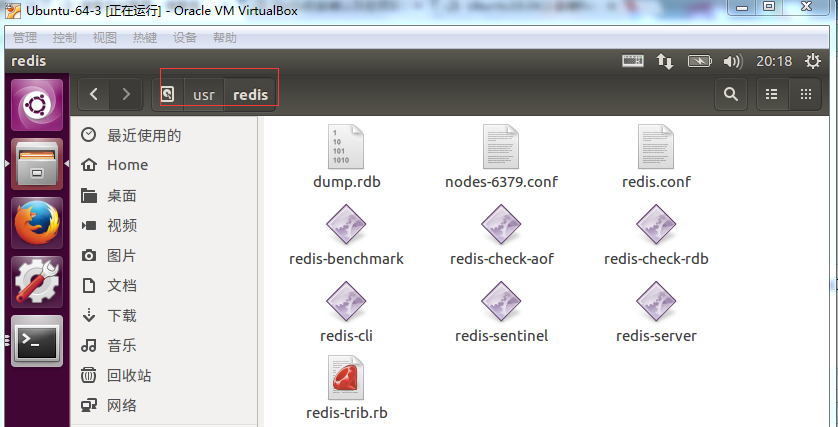
上面这两台服务器中的三个redis服务地址分别为:192.168.0.109:6379 192.168.0.109:6390 192.168.0.111:6379,在进行第三部的时候要用到。
(3)第三台机器的配置
上面的两步中我们共开起了三台主redis节点,所以在第三台服务器上我们也要开启三台从节点,结果如下:
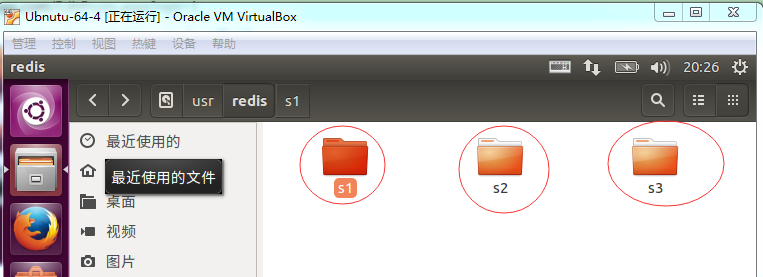
其中s1、s2、s3中文件和上面的一样,即三台从的redis节点。我们需要一个一个安装上面的配置修改redis.conf文件,只不过需要注意,三个节点的端口号是不一样的。s1、s2、s3的端口号分别是:6379 6380 6381
到现在个个redis节点的配置文件也修改好了,下面我们要分别启动s1 s2 s3 和上面的三个主redis服务了~~~~~~
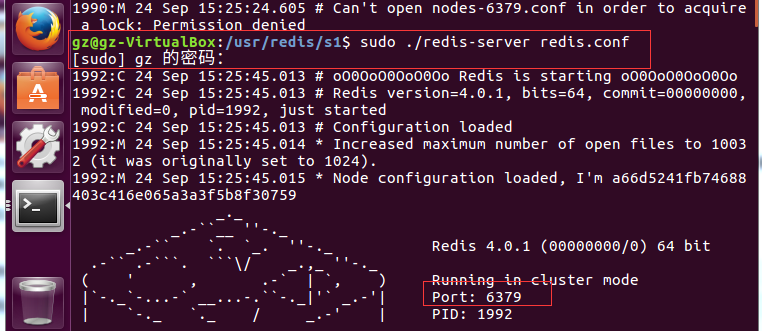
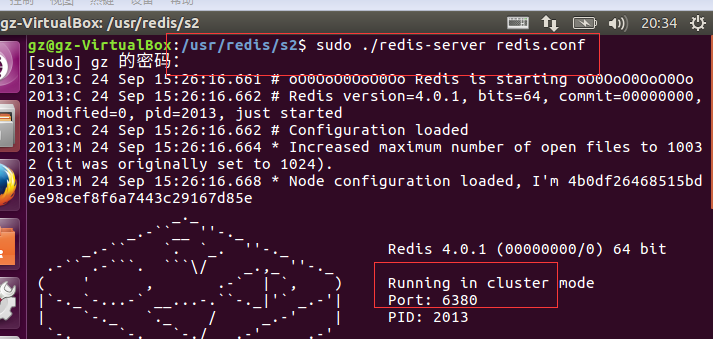
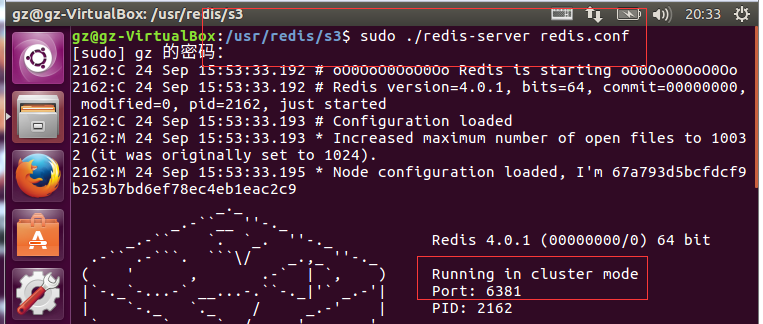
接下来,这三个服务都会生产一个这样的文件:
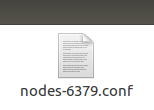
因为redis-trib.rb是ruby写的,不信可以打开看看。而在我们的Ubuntu16.04.1上是有ruby的环境的,但是还是强烈建议执行以下下面的指令 安装ruby,同时还要安装 ruby的Redis库,不过没关系,我们可以按照下面的步骤安装。
- 安装Redis-Cluster的依赖库(可能在安装依赖库的时候特别慢,可以使用加速器,我就不在这里说了,你懂的)
-
安装Ruby
sudo apt-get install ruby
-
安装Redis.gemsudo gem intall redis
-
耐心等待,因为很慢的(#^.^#)。安装好之后,执行下面图中划的命令:
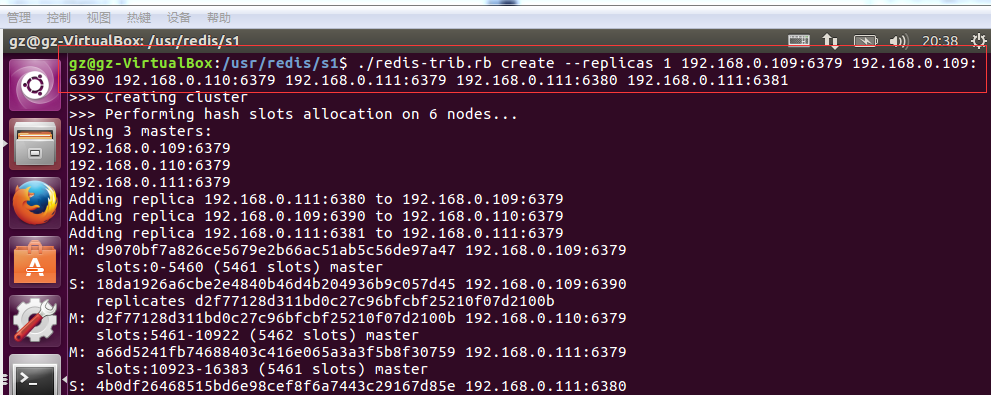
解释:./redis-trib.rb create --replicas 1 192.168.0.109:6379 192.168.0.109:6390 192.168.0.110:6379 192.168.0.111:6379 192.168.0.111:6380 192.168.0.111:6381
这些IP都是上面redis服务的IP,注意他们之间是有空格分开的。
如果出现上面的信息说明安装成功了!!!
其中:192.168.0.109:6379、192.168.0.110:6379/192.168.0.111:6379是主,192.168.0.111:6380/192.168.0.109:6390、192.168.0.111:6381是从的。
(4)测试是否成功
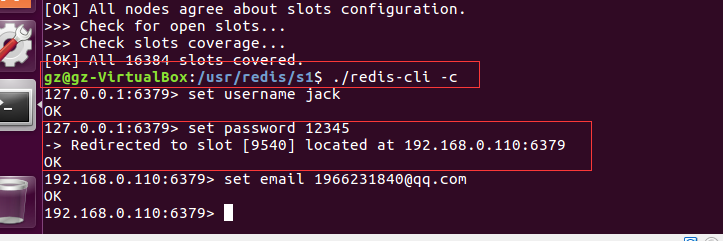
在到192.168.0.110:6379中看看有没有值:
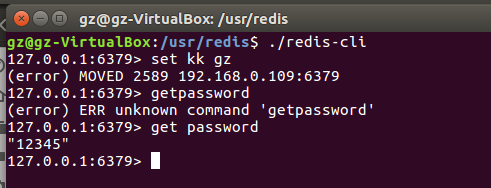
看到没,值同步过来了!!!!
三、面对Redis-ClusterC#该如何操作
step1:使用VS2017新建一个控制台程序
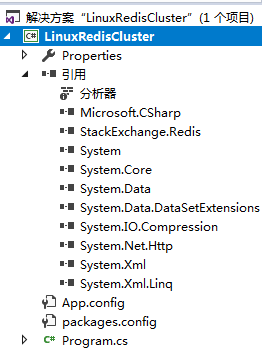
step2: Install-Package StackExchange.Redis
step3:编写代码:
1 using StackExchange.Redis; 2 using System; 3 using System.Collections.Generic; 4 using System.Linq; 5 using System.Text; 6 using System.Threading.Tasks; 7 8 namespace LinuxRedisCluster 9 { 10 class Program 11 { 12 static void Main(string[] args) 13 { 14 using (ConnectionMultiplexer redis = ConnectionMultiplexer.Connect("192.168.0.109:6379,192.168.0.109:6390,192.168.0.110:6379,192.168.0.111:6379,192.168.0.111:6380,192.168.0.111:6381")) 15 { 16 17 IDatabase db = redis.GetDatabase(); 18 for (int i = 0; i < 1000; i++) 19 { 20 db.StringSet("name"+i, "guozheng"+i); 21 } 22 23 24 //var myname = db.StringGet("name"); 25 // Console.WriteLine(myname); 26 } 27 28 Console.ReadKey(); 29 } 30 } 31 }
step4:查看结果:

四、总结:
关于redis如何集群的详细信息,可以参考Redis手册:集群教程
也可以参考下面这些博客:
http://www.cnblogs.com/huangxincheng/p/5615037.html
http://www.cnblogs.com/piscesLoveCc/p/5779795.html
觉得可以的话,希望点下推荐哈~你们的推荐是我的动力。
基础篇
.Neter玩转Linux系列之二:Linux下的文件目录及文件目录的权限
.Neter玩转Linux系列之四:Linux下shell介绍以及TCP、IP基础
.Neter玩转Linux系列之五:crontab使用详解和Linux的进程管理以及网络状态监控
.Neter玩转Linux系列之六:Linux下MySQL的安装、配置、使用
实战篇
Ubuntu16.04.1上搭建分布式的Redis集群,并使用C#操作
作者:郭峥
出处:http://www.cnblogs.com/runningsmallguo/
本文版权归作者和博客园共有,欢迎转载,但未经作者同意必须保留此段声明,且在文章页面明显位置给出原文链接。





【推荐】国内首个AI IDE,深度理解中文开发场景,立即下载体验Trae
【推荐】编程新体验,更懂你的AI,立即体验豆包MarsCode编程助手
【推荐】抖音旗下AI助手豆包,你的智能百科全书,全免费不限次数
【推荐】轻量又高性能的 SSH 工具 IShell:AI 加持,快人一步
· 如何编写易于单元测试的代码
· 10年+ .NET Coder 心语,封装的思维:从隐藏、稳定开始理解其本质意义
· .NET Core 中如何实现缓存的预热?
· 从 HTTP 原因短语缺失研究 HTTP/2 和 HTTP/3 的设计差异
· AI与.NET技术实操系列:向量存储与相似性搜索在 .NET 中的实现
· 周边上新:园子的第一款马克杯温暖上架
· Open-Sora 2.0 重磅开源!
· 分享 3 个 .NET 开源的文件压缩处理库,助力快速实现文件压缩解压功能!
· Ollama——大语言模型本地部署的极速利器
· DeepSeek如何颠覆传统软件测试?测试工程师会被淘汰吗?